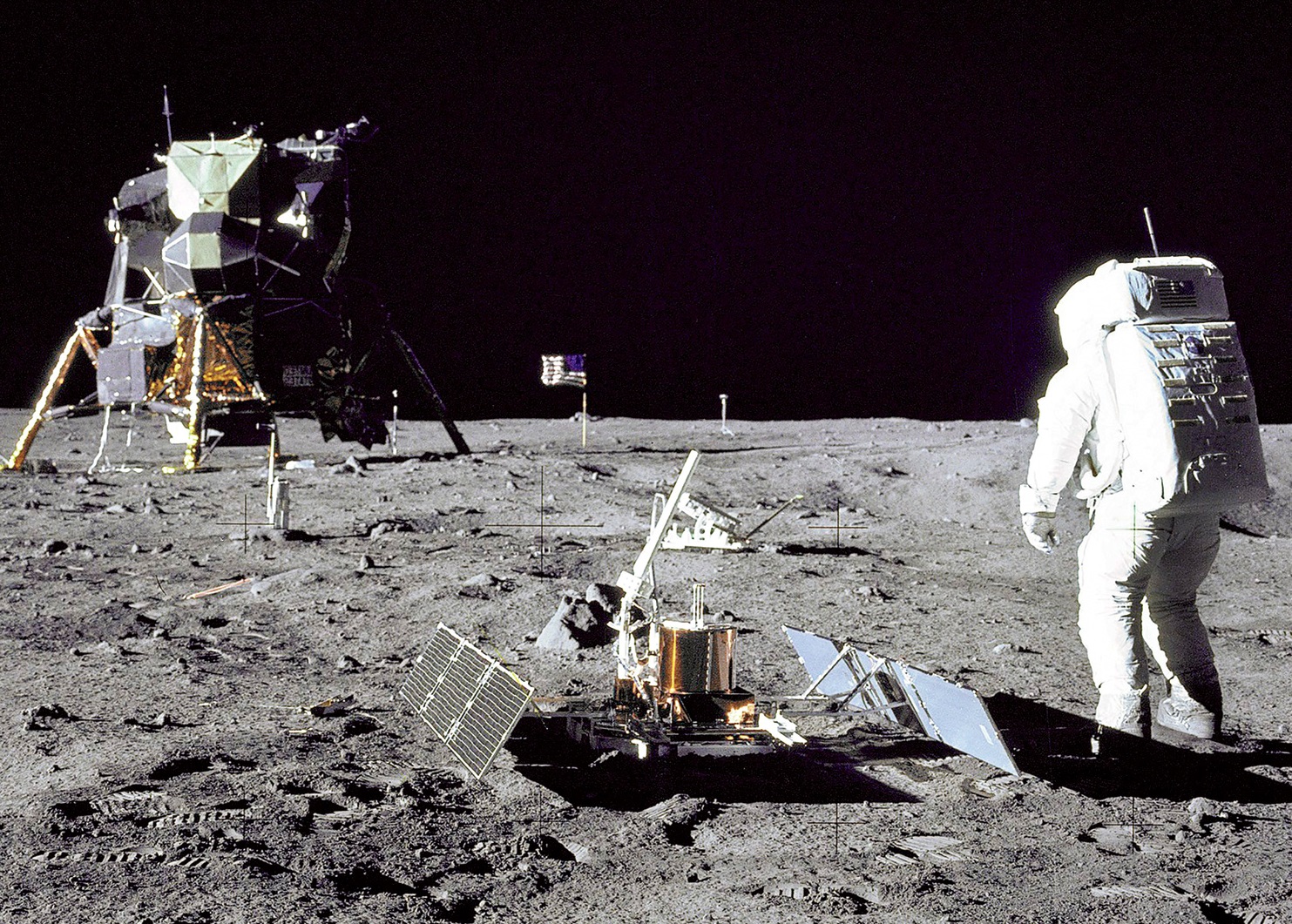

Introduction: Why Apollo 11 Still Matters
On July 20, 1969, NASA’s Apollo 11 mission achieved the first crewed landing on the Moon, turning a bold vision into concrete footprints on lunar dust. Commanded by Neil A. Armstrong with Buzz Aldrin (Lunar Module Pilot) and Michael Collins (Command Module Pilot), the mission fulfilled President Kennedy’s 1961 goal to land humans on the Moon and return them safely to Earth. Beyond the flag and the famous words, Apollo 11 catalyzed advances in computing, materials, communications, and systems engineering that still shape our world. This article walks through the full journey—planning, launch, landing, moonwalks, and return—plus the mission’s human experiences and lasting legacy. Mission Overview at a Glance Program: Apollo Mission: Apollo 11 (first crewed lunar landing) Launch Vehicle: Saturn V Launch: July 16, 1969, Cape Kennedy (now Cape Canaveral), Florida Lunar Landing: July 20, 1969, Mare Tranquillitatis (Sea of Tranquility) EVA (Moonwalk) Start: July 21, 1969 UTC Splashdown: July 24, 1969, Pacific Ocean Crew: Neil Armstrong, Buzz Aldrin, Michael Collins Before Liftoff: Training, Hardware, and Risk NASA’s success rode on relentless testing. Astronauts logged thousands of hours in simulators that modeled every conceivable fault. The Saturn V, a three-stage, 363-foot rocket, delivered the power to escape Earth’s gravity. The stack included the Command/Service Module (CSM) “Columbia” for transit and the Lunar Module (LM) “Eagle” for landing. Teams prepared intricate contingency procedures—manual landing skills, abort modes, and communications handoffs—knowing the margin for error on the Moon would be razor-thin. The Journey: Earth to Moon Launch & Earth Orbit: On July 16, the Saturn V thundered skyward. After reaching Earth orbit, the third stage reignited for Trans-Lunar Injection (TLI), setting the spacecraft on a multi-day path to the Moon. Transposition & Docking: Armstrong rotated the CSM, docked with the LM housed in the third stage, and extracted it. The crew then coasted through cislunar space, performing midcourse corrections, navigation checks with sextants and computers, and systems inspections. Arrival and Descent: “Eagle” Seeks Safe Ground Entering lunar orbit, Armstrong and Aldrin boarded the Eagle and separated from Collins in Columbia. During powered descent, Armstrong saw a boulder-strewn field and took semi-manual control to avoid hazards, guiding Eagle beyond the planned target. Fuel ran low—seconds of margin—before landing on the Sea of Tranquility. The now-iconic call: “Houston, Tranquility Base here. The Eagle has landed.” First Steps: Science, Symbols, and Sensation Stepping onto the Moon at 02:56 UTC on July 21, 1969, Armstrong described it as “one small step for [a] man, one giant leap for mankind.” Aldrin joined him, calling the view “magnificent desolation.” The pair conducted a carefully timed EVA (extravehicular activity), which included: Site Survey & Photography: Panoramas and close-ups to document terrain and landing effects. Experiments: The Early Apollo Scientific Experiments Package (EASEP) deployed instruments such as a passive seismometer to detect moonquakes and a laser retroreflector used to this day for precise Earth-Moon distance measurements. A solar wind composition experiment collected particles for analysis. Sample Collection: Approximately 21.5 kg (47.5 lb) of lunar rocks and soil, later revealing ancient volcanic history and a dry, airless environment. Symbolic Acts: The U.S. flag planting, a stainless-steel plaque declaring “We came in peace for all mankind,” and memorial items for fallen Soviet and American astronauts/cosmonauts. All the while, Michael Collins orbited alone in Columbia, conducting experiments, managing systems, and standing by as the vital ride home. The Trip Home: Ascent, Rendezvous, and Quarantine After rest and systems checks, Eagle’s ascent stage launched from the lunar surface to rendezvous with Columbia. The crew performed Trans-Earth Injection (TEI) and coasted home, completing midcourse corrections and airing global TV updates. On July 24, the spacecraft re-entered Earth’s atmosphere and splashed down in the Pacific Ocean, where the USS Hornet recovered the crew. To mitigate uncertainty about lunar pathogens, the astronauts entered a 21-day quarantine in the Mobile Quarantine Facility, emerging healthy and celebrated worldwide. The Human Experience: Courage, Pressure, and Precision The mission was as psychological as it was technical. In the LM, Armstrong’s heart rate spiked during the manual landing as fuel dwindled. Aldrin’s methodical callouts kept the cockpit synchronized. Collins spoke later about the profound isolation of orbiting the Moon alone—responsible for every system and painfully aware that if Eagle couldn’t launch, he would return to Earth solo. Yet, throughout, the crew radiated professionalism born of rigorous training and mutual trust. Technologies that Made It Possible Saturn V: Unmatched heavy-lift capability at the time. Apollo Guidance Computer (AGC): A pioneering integrated-circuit computer enabling real-time navigation and control, with innovative user interface “Verb/Noun” commands. Inertial Navigation & Rendezvous Radar: Allowed precise docking and landing. Mission Control: Real-time telemetry and decision-making in Houston coordinated specialists across propulsion, guidance, life support, and comms. Materials & Life Support: Lightweight alloys, thermal protection, and closed-loop systems kept the crew alive in vacuum and extremes of temperature. Global Impact and Legacy Apollo 11 united a divided planet, with an estimated hundreds of millions watching live. The mission accelerated innovations in microelectronics, software engineering, telecommunications, and quality assurance that cascaded into commercial products and later space endeavors. Scientifically, Apollo samples rewrote lunar history, and instruments left on the surface transformed lunar geophysics. Culturally, “Apollo” became shorthand for audacious goals met with disciplined execution—a template for tackling grand challenges. Key Facts (Quick Reference) Crew: Neil Armstrong, Buzz Aldrin, Michael Collins Vehicle: Saturn V; CSM “Columbia,” LM “Eagle” Dates: Launch July 16, 1969; landing July 20; first step July 21 (UTC); splashdown July 24 Landing Site: Sea of Tranquility Samples: ~21.5 kg returned Firsts: First crewed lunar landing and EVA on the Moon FAQs (SEO-Friendly) Q1: Who was the first person on the Moon? Neil Armstrong, followed by Buzz Aldrin; Michael Collins remained in lunar orbit. Q2: Where did Apollo 11 land? In Mare Tranquillitatis (Sea of Tranquility), a relatively smooth basaltic plain. Q3: What experiments were conducted? A passive seismometer, laser retroreflector, and solar wind collector, plus photography and sample collection. Q4: How long was the moonwalk? About 2.5 hours of EVA on the lunar surface. Q5: Why the quarantine? A precaution against unknown lunar microorganisms; none were found. How to Reference Apollo 11 Today (Internal Linking Ideas) Link to articles on Saturn V, Apollo Guidance Computer, Apollo program timeline, Michael Collins biography, Sea of Tranquility geology, and laser lunar ranging. Create related posts: “What Apollo 11 Taught Us About Systems Engineering,” “From Apollo to Artemis: Returning to the Moon,” “Top Apollo Artifacts You Can See in Museums.” Target Keywords (Use Naturally) Primary: Apollo 11, NASA first trip to the Moon, first Moon landing Secondary: Neil Armstrong, Buzz Aldrin, Michael Collins, Saturn V, Lunar Module Eagle, Sea of Tranquility, Apollo Guidance Computer, Moon rocks, 1969 Moon landing Long-Tail: Apollo 11 timeline and facts, what experiments did Apollo 11 do, how Apollo 11 returned to Earth, Apollo 11 quarantine explained

You must be logged in to post a comment.